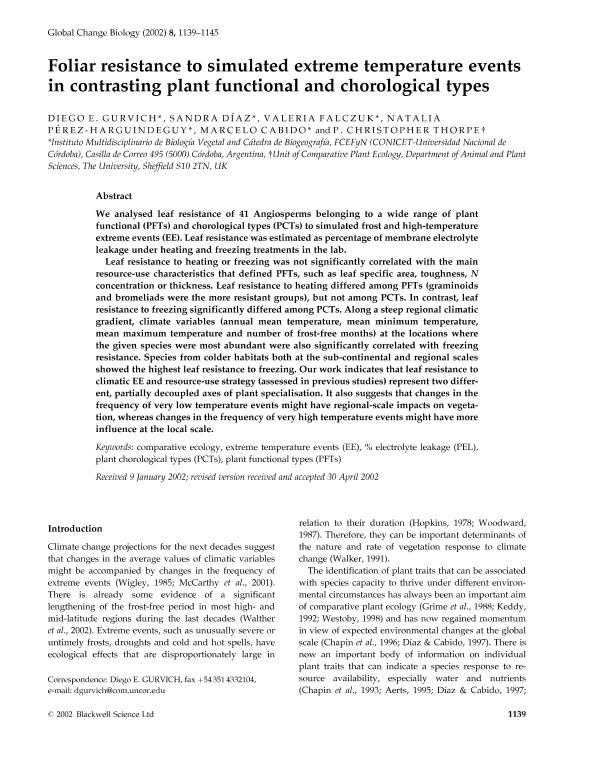Mostrar el registro sencillo del ítem
dc.contributor.author
Gurvich, Diego Ezequiel

dc.contributor.author
Díaz, Sandra Myrna

dc.contributor.author
Falczuk, Valeria

dc.contributor.author
Pérez Harguindeguy, Natalia

dc.contributor.author
Cabido, Marcelo Ruben

dc.contributor.author
Thorpe, P. Christopher
dc.date.available
2018-03-07T17:36:11Z
dc.date.issued
2002-11
dc.identifier.citation
Gurvich, Diego Ezequiel; Díaz, Sandra Myrna; Falczuk, Valeria; Pérez Harguindeguy, Natalia; Cabido, Marcelo Ruben; et al.; Foliar resistance to simulated extreme temperature events in contrasting plant functional and chorological types; Wiley Blackwell Publishing, Inc; Global Change Biology; 8; 11; 11-2002; 1139-1145
dc.identifier.issn
1354-1013
dc.identifier.uri
http://hdl.handle.net/11336/38130
dc.description.abstract
We analysed leaf resistance of 41 Angiosperms belonging to a wide range of plant functional (PFTs) and chorological types (PCTs) to simulated frost and high-temperature extreme events (EE). Leaf resistance was estimated as percentage of membrane electrolyte leakage under heating and freezing treatments in the lab. Leaf resistance to heating or freezing was not significantly correlated with the main resource-use characteristics that defined PFTs, such as leaf specific area, toughness, N concentration or thickness. Leaf resistance to heating differed among PFTs (graminoids and bromeliads were the more resistant groups), but not among PCTs. In contrast, leaf resistance to freezing significantly differed among PCTs. Along a steep regional climatic gradient, climate variables (annual mean temperature, mean minimum temperature, mean maximum temperature and number of frost-free months) at the locations where the given species were most abundant were also significantly correlated with freezing resistance. Species from colder habitats both at the sub-continental and regional scales showed the highest leaf resistance to freezing. Our work indicates that leaf resistance to climatic EE and resource-use strategy (assessed in previous studies) represent two different, partially decoupled axes of plant specialisation. It also suggests that changes in the frequency of very low temperature events might have regional-scale impacts on vegetation, whereas changes in the frequency of very high temperature events might have more influence at the local scale.
dc.format
application/pdf
dc.language.iso
eng
dc.publisher
Wiley Blackwell Publishing, Inc

dc.rights
info:eu-repo/semantics/openAccess
dc.rights.uri
https://creativecommons.org/licenses/by-nc-sa/2.5/ar/
dc.subject
% ELECTROLYTE LEAKAGE (PEL)
dc.subject
COMPARATIVE ECOLOGY
dc.subject
EXTREME TEMPERATURE EVENTS (EE)
dc.subject
PLANT CHOROLOGICAL TYPES (PCTS)
dc.subject
PLANT FUNCTIONAL TYPES (PFTS)
dc.subject.classification
Otras Ciencias Biológicas

dc.subject.classification
Ciencias Biológicas

dc.subject.classification
CIENCIAS NATURALES Y EXACTAS

dc.title
Foliar resistance to simulated extreme temperature events in contrasting plant functional and chorological types
dc.type
info:eu-repo/semantics/article
dc.type
info:ar-repo/semantics/artículo
dc.type
info:eu-repo/semantics/publishedVersion
dc.date.updated
2018-03-07T16:05:58Z
dc.journal.volume
8
dc.journal.number
11
dc.journal.pagination
1139-1145
dc.journal.pais
Reino Unido

dc.journal.ciudad
Londres
dc.description.fil
Fil: Gurvich, Diego Ezequiel. Consejo Nacional de Investigaciones Científicas y Técnicas. Centro Científico Tecnológico Conicet - Córdoba. Instituto Multidisciplinario de Biología Vegetal. Universidad Nacional de Córdoba. Facultad de Ciencias Exactas Físicas y Naturales. Instituto Multidisciplinario de Biología Vegetal; Argentina
dc.description.fil
Fil: Díaz, Sandra Myrna. Consejo Nacional de Investigaciones Científicas y Técnicas. Centro Científico Tecnológico Conicet - Córdoba. Instituto Multidisciplinario de Biología Vegetal. Universidad Nacional de Córdoba. Facultad de Ciencias Exactas Físicas y Naturales. Instituto Multidisciplinario de Biología Vegetal; Argentina
dc.description.fil
Fil: Falczuk, Valeria. Consejo Nacional de Investigaciones Científicas y Técnicas. Centro Científico Tecnológico Conicet - Córdoba. Instituto Multidisciplinario de Biología Vegetal. Universidad Nacional de Córdoba. Facultad de Ciencias Exactas Físicas y Naturales. Instituto Multidisciplinario de Biología Vegetal; Argentina
dc.description.fil
Fil: Pérez Harguindeguy, Natalia. Consejo Nacional de Investigaciones Científicas y Técnicas. Centro Científico Tecnológico Conicet - Córdoba. Instituto Multidisciplinario de Biología Vegetal. Universidad Nacional de Córdoba. Facultad de Ciencias Exactas Físicas y Naturales. Instituto Multidisciplinario de Biología Vegetal; Argentina
dc.description.fil
Fil: Cabido, Marcelo Ruben. Consejo Nacional de Investigaciones Científicas y Técnicas. Centro Científico Tecnológico Conicet - Córdoba. Instituto Multidisciplinario de Biología Vegetal. Universidad Nacional de Córdoba. Facultad de Ciencias Exactas Físicas y Naturales. Instituto Multidisciplinario de Biología Vegetal; Argentina
dc.description.fil
Fil: Thorpe, P. Christopher. University of Sheffield; Reino Unido
dc.journal.title
Global Change Biology

dc.relation.alternativeid
info:eu-repo/semantics/altIdentifier/doi/http://dx.doi.org/10.1046/j.1365-2486.2002.00540.x
dc.relation.alternativeid
info:eu-repo/semantics/altIdentifier/url/http://onlinelibrary.wiley.com/doi/10.1046/j.1365-2486.2002.00540.x/abstract
Archivos asociados
